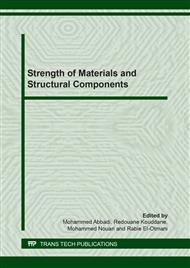[1]
P. E. Becher, A. Pedersen, Application of Statistical Linear Elastic Fracture Mechanics to Pressure Vessel Reliability Analysis, Nuclear Engineering and Design, 27 (1974) 413-425.
DOI: 10.1016/0029-5493(74)90184-8
Google Scholar
[2]
W. Marshall, An Assessment of the Integrity of PWR Pressure Vessel, UK. AEA, (1976).
Google Scholar
[3]
D.O. Harris, E.Y. Lim, D.D. Dedhia, Probability of Pipe Fracture in the Primary Coolant Loop of a PWR Plant, Vol. 5: Probabilistic Fracture Mechanics Analysis, NUREG/CR-2189, Vol. 5, U.S. Nuclear Regulatory Commission, Washington, DC, August (1981).
DOI: 10.2172/5341468
Google Scholar
[4]
H. Machida, Effect of Dispersion of Seismic Load on Integrity of Nuclear Power Plant Pipin, M -Structural Reliability and Probabilistic Safety Assessment (PSA) M01- SMiRT 16 - Washington, DC, USA. August 12-17, (2001).
Google Scholar
[5]
T. Y. Lo, R. W. Mensing, H. H. Woo, G. S. Holman, Probability of pipe failure in the reactor coolant loops of combustion engineering PWR plants, Vol. 2 : Pipe failure induced by crack growth, NUREG/CR-3663, (1984).
DOI: 10.2172/6425305
Google Scholar
[6]
Y. Asada, K. Takumi, H. Hata, Y. Yamamoto, Development of Criteria for Protection Against Pipe Breaks in LWR Plants, International Journal of Pressure Vessels and Piping, 43(1990) 95-111.
DOI: 10.1016/0308-0161(90)90095-y
Google Scholar
[7]
A. Guedri, Reliability analysis of stainless steel piping using a single stress corrosion Cracking Damage Parameter. Int. Journal of Piping and Pressure vessel,111–112 (2013) 1–11.
DOI: 10.1016/j.ijpvp.2013.03.011
Google Scholar
[8]
A. Guedri, Effects of remedial actions on small piping reliability. Journal of Risk and Reliability, Proceedings of the IMechE (Part O), 227(2) (2013)144-161.
DOI: 10.1177/1748006x13477798
Google Scholar
[9]
A. Guedri, Y. Djebbar, M.A. Khaleel, A. Zaghloul, Structural Reliability Improvement Using In-Service Inspection for Intergranular Stress Corrosion of Large Stainless Steel Piping. (2012).
DOI: 10.5772/48521
Google Scholar
[10]
K. Sun-Hye, P. Jung-Soon, L. Jin-Ho, Y. Eun-Sub, K. Sun-Ye, S. Do-Jun, Korean Consortium's preliminary research for enhancing a probabilistic fracture mechanics code, PRO-LOCA, International Journal of Pressure Vessels and Piping, 131( 2015)75-84.
DOI: 10.1016/j.ijpvp.2015.04.012
Google Scholar
[11]
U. Makoto, K. Jinya, O. Kunio, L. Yinsheng, Failure probability analyses for PWSCC in Ni-based alloy welds, International Journal of Pressure Vessels and Piping, 131(2015)85-95.
DOI: 10.1016/j.ijpvp.2015.04.013
Google Scholar
[12]
A.C. Caputo, F. Paolacci, O.S. Bursi, R. Giannini, Problems and Perspectives in Seismic Quantitative Risk Analysis of Chemical Process Plants. ASME. J. Pressure Vessel Technol. 141(1), (2018)010901-010901-15.
DOI: 10.1115/1.4040804
Google Scholar
[13]
H. Phan, F. Paolacci, S. Alessandri, Enhanced Seismic Fragility Analysis of Unanchored Steel Storage Tanks Accounting for Uncertain Modeling Parameters. ASME. J. Pressure Vessel Technol. 141(1) (2018)010903-010903-10.
DOI: 10.1115/1.4039635
Google Scholar
[14]
A. Maekawa, T. Takahashi, Numerical Study on Inelastic Seismic Design of Piping Systems Using Damping Effect Based on Elastic–Plastic Property of Pipe Supports. ASME. J. Pressure Vessel Technol. 141(1)(2018)010907-010907-9.
DOI: 10.1115/1.4039697
Google Scholar
[15]
M. Hideo, A. Manabu, K. Yoshio, Probabilistic fracture mechanics analysis for pipe consider- ing dispersion of seismic loading, Nuclear Engineering and Design, 212(2002).1–12.
DOI: 10.1016/s0029-5493(01)00469-1
Google Scholar
[16]
M. Hideo, Y. Shinobu, Probabilistic fracture mechanics analysis of nuclear piping considering variation of seismic loading, International Journal of Pressure Vessels and Piping, 79(3)(2002) 193-202.
DOI: 10.1016/s0308-0161(02)00011-x
Google Scholar
[17]
E. Y. Lim, Probability of Pipe Fracture in the Primary Coolant Loop of a PWR Plant Volume 9: PRAISE Computer Code User's Manual Load Combination Program Project I Final Report NUREG/CR-2189, Vol. 9, (1981).
DOI: 10.2172/5336898
Google Scholar
[18]
M.A. Khaleel, F.A. Simonen, Evaluations of Structural Failure Probabilities and Candidate Inservice Inspection Programs. (2009).
DOI: 10.2172/974009
Google Scholar


